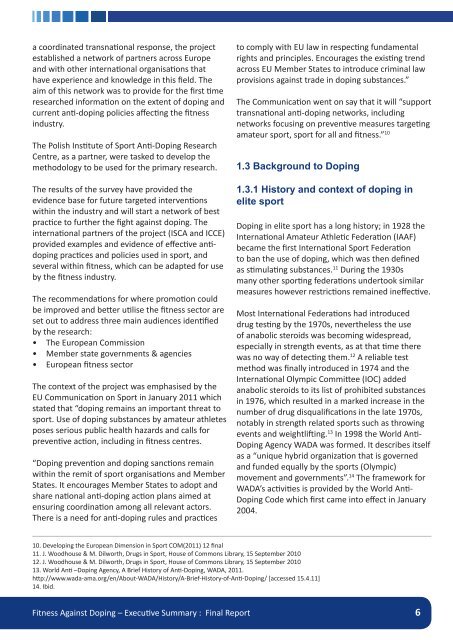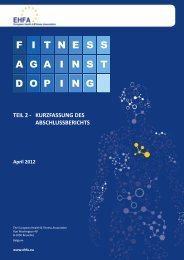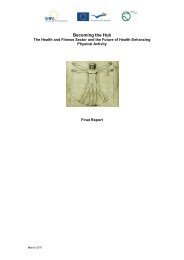FINAL REPORT - the EHFA Projects & Programmes
FINAL REPORT - the EHFA Projects & Programmes
FINAL REPORT - the EHFA Projects & Programmes
You also want an ePaper? Increase the reach of your titles
YUMPU automatically turns print PDFs into web optimized ePapers that Google loves.
a coordinated transnational response, <strong>the</strong> project<br />
established a network of partners across Europe<br />
and with o<strong>the</strong>r international organisations that<br />
have experience and knowledge in this field. The<br />
aim of this network was to provide for <strong>the</strong> first time<br />
researched information on <strong>the</strong> extent of doping and<br />
current anti-doping policies affecting <strong>the</strong> fitness<br />
industry.<br />
The Polish Institute of Sport Anti-Doping Research<br />
Centre, as a partner, were tasked to develop <strong>the</strong><br />
methodology to be used for <strong>the</strong> primary research.<br />
The results of <strong>the</strong> survey have provided <strong>the</strong><br />
evidence base for future targeted interventions<br />
within <strong>the</strong> industry and will start a network of best<br />
practice to fur<strong>the</strong>r <strong>the</strong> fight against doping. The<br />
international partners of <strong>the</strong> project (ISCA and ICCE)<br />
provided examples and evidence of effective antidoping<br />
practices and policies used in sport, and<br />
several within fitness, which can be adapted for use<br />
by <strong>the</strong> fitness industry.<br />
The recommendations for where promotion could<br />
be improved and better utilise <strong>the</strong> fitness sector are<br />
set out to address three main audiences identified<br />
by <strong>the</strong> research:<br />
• The European Commission<br />
• Member state governments & agencies<br />
• European fitness sector<br />
The context of <strong>the</strong> project was emphasised by <strong>the</strong><br />
EU Communication on Sport in January 2011 which<br />
stated that “doping remains an important threat to<br />
sport. Use of doping substances by amateur athletes<br />
poses serious public health hazards and calls for<br />
preventive action, including in fitness centres.<br />
“Doping prevention and doping sanctions remain<br />
within <strong>the</strong> remit of sport organisations and Member<br />
States. It encourages Member States to adopt and<br />
share national anti-doping action plans aimed at<br />
ensuring coordination among all relevant actors.<br />
There is a need for anti-doping rules and practices<br />
to comply with EU law in respecting fundamental<br />
rights and principles. Encourages <strong>the</strong> existing trend<br />
across EU Member States to introduce criminal law<br />
provisions against trade in doping substances.”<br />
The Communication went on say that it will “support<br />
transnational anti-doping networks, including<br />
networks focusing on preventive measures targeting<br />
amateur sport, sport for all and fitness.” 10<br />
1.3 Background to Doping<br />
10. Developing <strong>the</strong> European Dimension in Sport COM(2011) 12 final<br />
11. J. Woodhouse & M. Dilworth, Drugs in Sport, House of Commons Library, 15 September 2010<br />
12. J. Woodhouse & M. Dilworth, Drugs in Sport, House of Commons Library, 15 September 2010<br />
13. World Anti –Doping Agency, A Brief History of Anti-Doping, WADA, 2011.<br />
http://www.wada-ama.org/en/About-WADA/History/A-Brief-History-of-Anti-Doping/ [accessed 15.4.11]<br />
14. Ibid.<br />
1.3.1 History and context of doping in<br />
elite sport<br />
Doping in elite sport has a long history; in 1928 <strong>the</strong><br />
International Amateur Athletic Federation (IAAF)<br />
became <strong>the</strong> first International Sport Federation<br />
to ban <strong>the</strong> use of doping, which was <strong>the</strong>n defined<br />
as stimulating substances. 11 During <strong>the</strong> 1930s<br />
many o<strong>the</strong>r sporting federations undertook similar<br />
measures however restrictions remained ineffective.<br />
Most International Federations had introduced<br />
drug testing by <strong>the</strong> 1970s, never<strong>the</strong>less <strong>the</strong> use<br />
of anabolic steroids was becoming widespread,<br />
especially in strength events, as at that time <strong>the</strong>re<br />
was no way of detecting <strong>the</strong>m. 12 A reliable test<br />
method was finally introduced in 1974 and <strong>the</strong><br />
International Olympic Committee (IOC) added<br />
anabolic steroids to its list of prohibited substances<br />
in 1976, which resulted in a marked increase in <strong>the</strong><br />
number of drug disqualifications in <strong>the</strong> late 1970s,<br />
notably in strength related sports such as throwing<br />
events and weightlifting. 13 In 1998 <strong>the</strong> World Anti-<br />
Doping Agency WADA was formed. It describes itself<br />
as a “unique hybrid organization that is governed<br />
and funded equally by <strong>the</strong> sports (Olympic)<br />
movement and governments”. 14 The framework for<br />
WADA’s activities is provided by <strong>the</strong> World Anti-<br />
Doping Code which first came into effect in January<br />
2004.<br />
Fitness Against Doping – Executive Summary : Final Report 6




